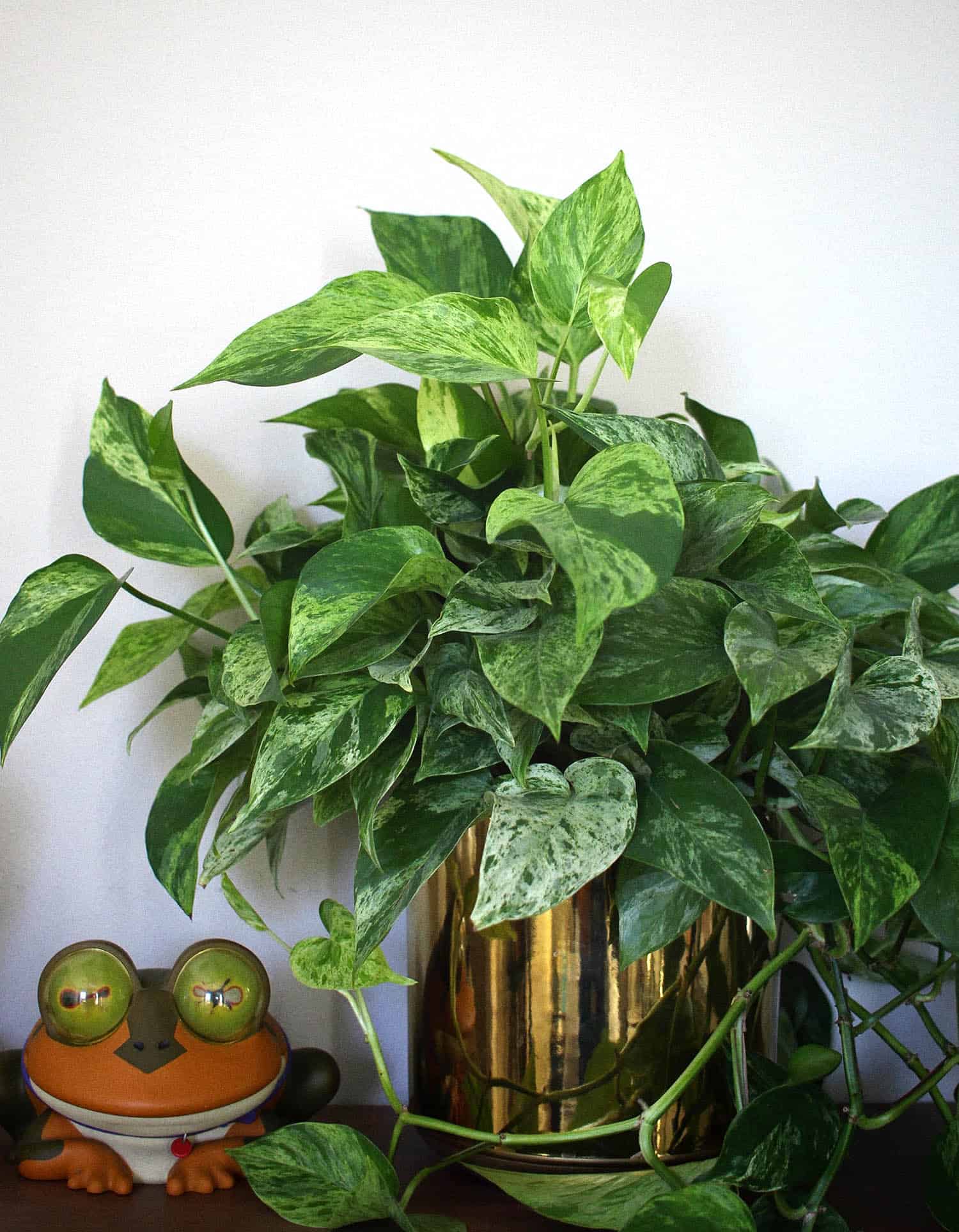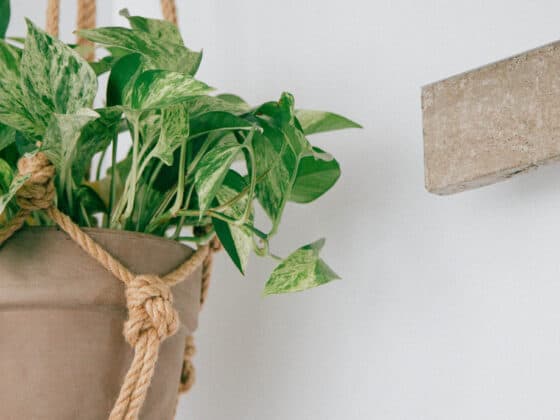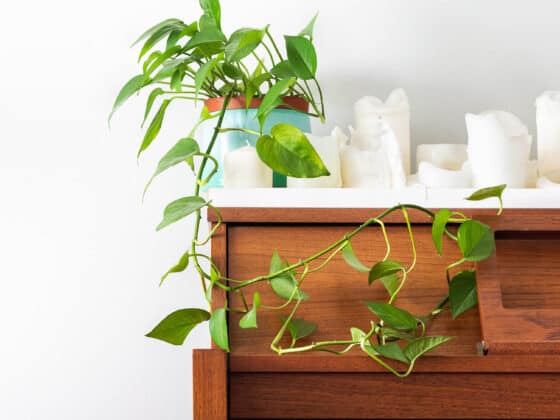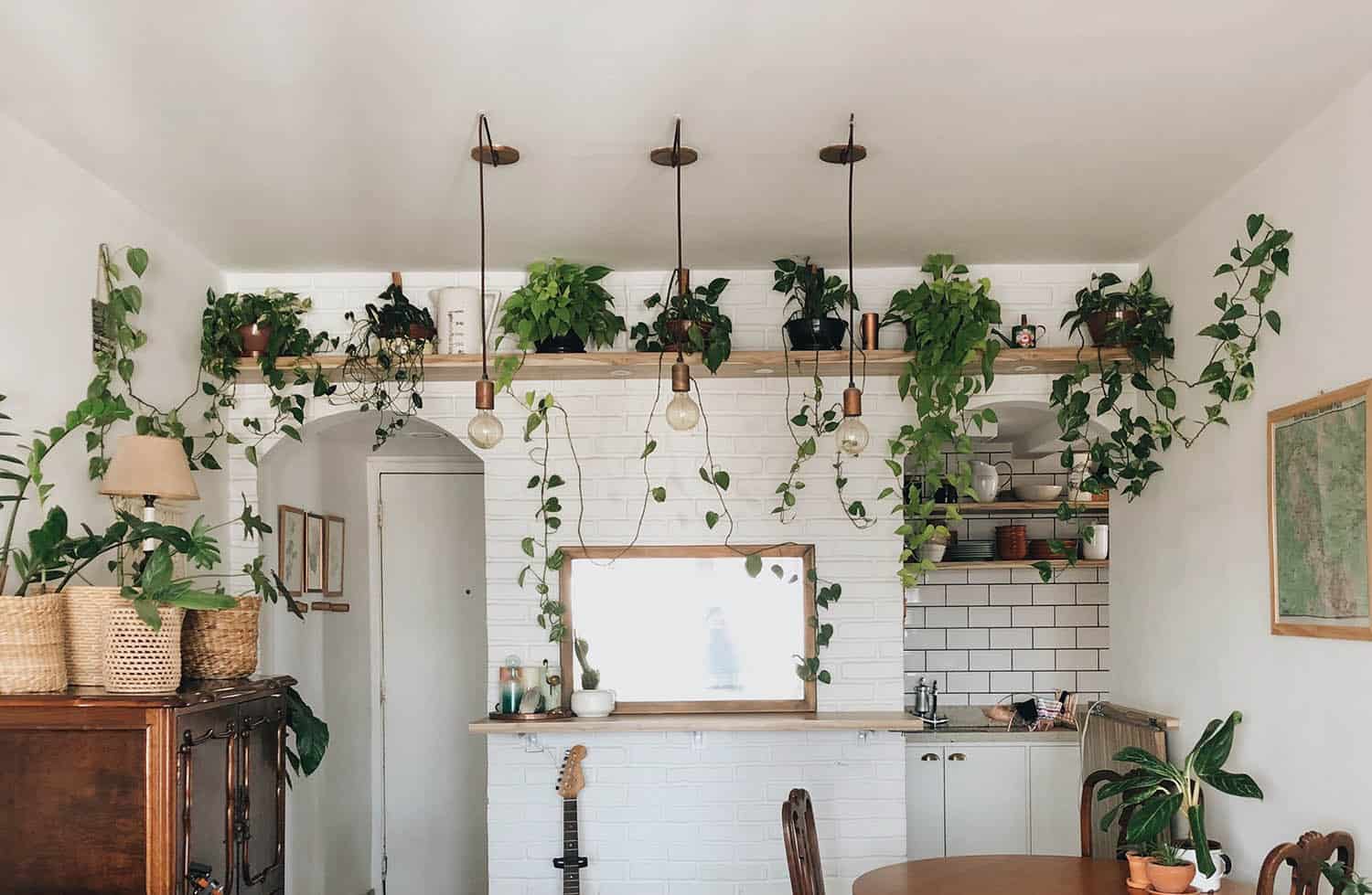Does your Pothos need a bigger pot? These fast-growing tropical plants are healthiest when you give their roots a chance to stretch out. But how do you know it’s time to repot your Pothos? We’ll explain the most important indicators that your Devil’s Ivy needs more space and how to repot it successfully.
You should move your Pothos to a bigger pot every 1-2 years, depending on how fast it’s growing. Slow growth, persistent dehydration, and soil that won’t hold water are all common signs that it’s time to repot your Pothos.
When repotting your Pothos, it’s usually best to increase its pot size by about 2 inches. Take the opportunity to give it some fresh potting mix, too. Being transplanted may stress your Pothos out at first, but it should recover quickly. And it will soon start showing healthier and more vigorous growth.
Why Should You Repot Your Pothos?
Every so often, we’ll stumble on an online advice post claiming that some plant or other “likes to be root bound”. According to these commenters, letting these plants “get a little tight” in their pots is good. We often hear these claims being made about Pothos.
Let’s nip this one in the bud: no, your Pothos doesn’t like to be root bound. Neither does any other plant.
Root binding is what happens when a plant gets too big for the pot it’s growing in. When roots run out of room to grow, they cram together and circle around the edges of the pot. The more they bunch up, the more they block each other’s access to water and nutrients. A root bound Pothos will soon start suffering from dehydration and malnutrition.
So why would anyone claim that plants like this? As far as we can tell, this misguided advice is an attempt to stop inexperienced gardeners from placing a Pothos in a pot that’s too big for it. But correcting an imbalance by going to the other extreme is usually a bad idea. Don’t cramp your Pothos because you’re afraid of drowning it.
Now that you understand why potting up is essential, let’s talk about when to do it. Here are the 6 main signs that it’s time to repot your Pothos:
#1: It’s Been a While
Are you looking at your Pothos plant and thinking, “When was the last time I repotted this thing?” If so, the answer is probably “Too long ago.” Epipremnum aureum is a fast-growing plant, and it’s best to repot it at least once every 2 years. If it’s getting a lot of sunlight, once per year may be better.
Note that a heavily variegated Pothos absorbs less light per leaf, so it usually grows more slowly. If you have a Snow Queen or a Manjula Pothos, you’re probably safe to repot it every 2 years. As always, use common sense. If your plant is under bright grow lights or in a greenhouse, it’s growing faster than most houseplants.
Repotting your Pothos regularly should help you avoid the other signs on this list, all of which usually mean that your plant is at least slightly root bound.
#2: Your Pothos Isn’t Growing
When your plant hits the limits of its growth, it stops growing, or at least slows down. Epipremnums are tough, so yours probably won’t come to a complete halt when it gets root bound. However, it won’t grow as vigorously as you’re used to.
Assuming it’s well-lit, well-nourished, and well-hydrated, your plant will typically grow 10-18 inches per month. A slower growth rate could be an indicator that it’s time to repot your Pothos. (But only if you’re sure you’re giving your plant everything else it needs to thrive.)
#3: The Leaves of Your Pothos are Yellow and Brown
The leaves of a root bound Pothos will eventually get starved of water and nutrients. Depleted foliage will turn yellow, then dry up to a dead and crispy brown. This process begins at the tips, moves to the edges, and finally spreads to cover the entire leaf.
Root rot and fertilizer burn can create similar effects, as can ordinary dehydration or malnutrition. Have you recently increased the amount of fertilizer you’re giving your Pothos? Is the soil soggy and wet? If the answer to both is “No”, then there’s a good chance your plant is root bound.
#4: Your Pothos’s Pot Won’t Hold Water
When Pothos roots get majorly overgrown, they don’t leave much room in the container for soil. And the first part of the potting mix to break down is the organic material that normally stores moisture. So if your Devil’s Ivy gets root bound, the pot will retain much less water.
When you water your Pothos, pay attention to what happens next. Does the liquid:
- A) Take a few seconds to slowly permeate the soil?
- B) Start flowing out of the drainage hole almost immediately?
Does the pot:
- A) Feel noticeably heavier and stay that way for a while?
- B) Seem no heavier than before once the water stops trickling?
Does your Pothos:
- A) Stay full and upright for the next 3-5 days?
- B) Perk up briefly, only to start wilting again a day or so later?
If you answered “B”, there’s very little water sticking around in the container. This is one of the most telling signs that the pot is full of roots and not much else. When that happens, it’s time to repot your Pothos.
#5: The Roots of Your Pothos are Escaping
When a root bound plant gets desperate enough, its roots will often try to strike out for greener pastures. They may push above the surface of the soil or slip through the drainage holes, hoping to find soil nearby.
Keep in mind that the roots might also creep out of the bottom of the pot if you’re consistently leaving water in the tray underneath. They can’t help it – they’re programmed to grow toward moisture. Always empty that saucer after watering your Pothos, or your plant might trick you into thinking it’s root bound.
On the other hand, it’s definitely time to repot your Pothos if it attempts a full-on jailbreak. It’s not unheard of for these plants to grow so quickly that they crack through the sides of their containers. If its terra cotta pot is splitting, or its plastic pot is bulging out in odd places, give your Pothos a bit more living space.
#6: The Soil is Always Wet
This is a very different scenario from the other entries on this list. Soggy potting mix doesn’t mean your Pothos is root bound – it means it’s in grave danger of root rot. The microbes that breed in dank, wet soil can infect your plant with a deadly disease.
This can happen because you’re watering too often, but potting mix with poor drainage is another possible culprit. If the soil stays noticeably wet for more than 3-4 days after each watering, it’s probably too dense. Repotting your plant could save its life.
In this case, you’re not repotting to give your Pothos more space. You’re giving it a growing medium that breathes better. A Pothos is happiest when a little more than half of its potting mix consists of chunky bits that don’t decay quickly. The following formula is a good starting point:
- 4 parts perlite
- 3 parts coconut coir
- 2 parts orchid bark
- 1 part worm castings
By the way, the need to keep the soil aerated is another good reason to repot your Pothos regularly. Most soil gets denser and spongier over time as the organic stuff inside it breaks down. Even if the potting mix was good when you first planted your Pothos, it might not be suitable anymore.
When in Doubt: Check the Roots
There is one surefire way to know whether your Pothos is rootbound…checking the roots themselves. If you slide your Pothos out of the pot and find roots balled up in the bottom, coiling and curling in on themselves, it is time to repot the plant. Remember that crowded roots have a difficult time absorbing water and nutrients, so if your plant is root bound, it is time to up the size of the planter.
How to Repot Your Pothos
The best time to repot your Pothos is just as the growing season is revving up. That means mid-spring, when the days are getting noticeably longer. However, if your plant’s health is suffering, don’t wait for the perfect moment to repot.
Pick a container that’s about 2 inches wider than the current one. (If it’s been way too long since you repotted, you could go 3-4 inches bigger.) Always choose a pot with a hole in the base for drainage.
Prepare some of the coarse potting mix we described above and moisten it just a bit. Fill about ⅓ of the new pot with this soil.
Then slide your Pothos out of its pot and check how the roots are doing. If they’re crammed together like packaged ramen noodles, the plant is root bound. Use your fingers to gently spread the root mass out.
If some of the roots are circling around the others, slice through them with a disinfected garden knife. You might also want to saw off the bottom ¼-⅓ of the root ball, giving your Pothos room to grow.
Roots that are brown, black, squishy, and slimy are rotting. We have an in-depth guide on curing root rot in Pothos here, but the short version is that you need to cut off all the infected roots. Make sure to sanitize your clippers between cuts.
Once the roots are prepped, slide your Pothos into its new pot. Bury the roots with more of the potting mix you prepped. Shake the pot a little as you go, settling the soil into the gaps.
Caring For Pothos After You Repot
Your Pothos will probably wilt for a week or two after you repot it, and may even lose a few leaves. But if you’re gentle with it, it will come back around. Be careful not to overwater or put your plant in direct sunlight while it recovers. When the root system isn’t at 100%, the plant is especially vulnerable to dehydration and root rot.
Keep the humidity above 50% if you can. This helps to buffer the plant against excessive heat and encourages healthy root growth. A humidifier is the easiest way to do this. In a pinch, you could also pop a clear plastic bag over the foliage to hold in moisture.
Once your Pothos begins producing new leaves, you’ll know it’s back on track. At this point, you can care for it as normal. Just remember it will be time to repot your Pothos again in a year or two!
Final Thoughts
Regular repotting is an essential part of Pothos care, and it’s less work if you do it proactively. If you give your plant a bigger pot every year or two, you’ll never need to chop through or pry apart overgrown roots! Pay attention to how fast your Pothos is growing so you can give it the space it needs to thrive.















